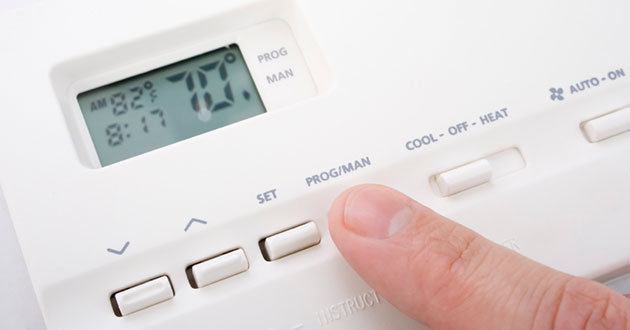WHAT TEMPERATURE SHOULD I SET MY THERMOSTAT TO?
Jun 10, 2018

Your thermostat is one of several tools that helps you adjust the comfort level in your home. But thermostat temperature settings can be tricky. (Learn more about how to set thermostat temperature.) When you find yourself asking, “What temperature should my home be?” the answer is actually more complicated than you might think.
The Cost of Comfort
If you want to save money on your HVAC bills, your thermostat temperature settings should mimic the weather outside. Your HVAC system will have to work very little to maintain homeostasis with the outside air. Want to save the most money? Turn your HVAC system off altogether!
Of course, that strategy doesn’t work when it’s blazingly hot or blindingly cold outside. Even then, though, changing your thermostat temperature settings should be a last resort rather than your go-to option. Once you’ve set your programmable thermostat, do your best not to touch it. Remember, cranking it up or lowering it dramatically won’t make your home heat up or cool down any faster.
Take a look at some of these cases. Should you change your thermostat temperature settings?
WHAT SHOULD MY THERMOSTAT BE SET TO IN WINTER?
It’s wintertime and you’ve kept your thermostat temperature settings at a reasonable 67°. A cold front is coming, though, so you’re wondering how to set the thermostat temperature to keep your house warm.
While this is a common justification for increasing thermostat temperature settings, it doesn’t make any logical (or financial) sense. If you’re comfortable at 67°, you’re going to remain comfortable at that temperature – whether it’s 25° or 95° outside.
YOU WANT TO HEAT OR COOL A ROOM QUICKLY.
A thermostat cannot control the speed at which your home’s temperature increases or decreases. It can only control the temperature inside your home. (Learn more about how a thermostat works here.) Increasing thermostat temperature settings will make your room warmer over time, but a higher setting won’t make the house heat up any more quickly.
Just set the thermostat to the temperature at which you feel most comfortable. When it’s extremely hot or cold outside, it may take a bit longer for your HVAC system to reach your ideal temperature. If you have extreme thermostat temperature settings, though, you’re going to end up with a system that’s doing too much work and a house that is ultimately not at your optimum temperature.
WHAT SHOULD MY THERMOSTAT BE SET TO ON VACATION?
Going on a vacation? Here’s the one instance where you do want to change your thermostat temperature settings! If you’re not going to be home for a while, it doesn’t make sense to maintain temperatures you find comfortable. Follow these guidelines for proper thermostat temperature settings when you’re on vacation, and you won’t face such hefty bills when you return.
What are the optimum thermostat temperature settings?
The actual temperature settings you should use is a matter of personal preference. Try to find something that every family member finds reasonably comfortable so you can avoid ‘thermostat wars.’ Ask each person what their optimum temperature is for daytime and nighttime, and then program your thermostat to the average.
Everyone will be within a few degrees of their optimum thermostat temperature settings, and people who run hot or cold can easily fix it by putting on a sweater or taking off shoes and socks. Changing clothes won’t alter your home’s temperature, but it will improve your comfort – and that’s what you’re really trying to change, right?
If you’re feeling warm, open a window. Ceiling fans can help you cool off or warm-up. Thermostat temperature settings should not be your first or only line of defense against fluctuating temperatures. There are several other ways to get comfortable without overpaying for energy. See tips for Summer Thermostat Settings here.
If you’re not misusing your thermostat and can’t seem to get comfortable, your heating and cooling system might require maintenance. Newcomb & Company can examine your system to see if it’s operating at peak efficiency. Contact us today to schedule a service call or learn more about lowering your energy bill.
Need help? Call now.